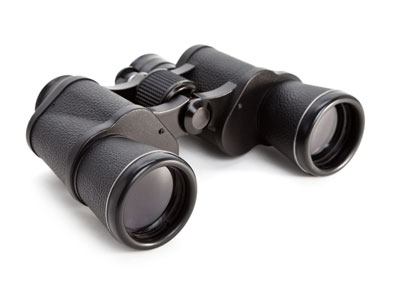Why is everything so small down there?
How does this align with my curriculum?
Explore how we see things far and near and from different angles. It's all about perspective!
What You Need
- A high place for viewing objects positioned at a lower level (e.g. a tree house, hill, tall building)
- A toy such as a stuffed animal
- Binoculars (optional)
Safety First!
Use caution when climbing high places.
What To Do
- Find a high place to climb and place the small toy at the bottom of this place, where it will be visible from above. Compare the size of the toy to something that you will have when you climb to the top (e.g. is it as big as your hand? Smaller than your shoe?)
- Climb to the high place and look down at the toy. Does it seem as big? How does it compare to the size before your climb? Can you see all of the toy or just a part of it?
- Optional: Look at the toy through binoculars. How does the toy look different? The same?
Discovery
When we view objects found in the world from a distance, the objects appear smaller than they actually are. When we see any object, light from the object enters the eye and an inverted image is projected onto the back of the eye.
When an object is far away, the light from the object is projected at such a large angle that it causes the object to appear smaller. Likewise, when an object is close, the light from the object is projected at a small angle and the image appears larger.
Binoculars are like two side-by-side telescopes. Light from the object being viewed is gathered into special lenses that reflect and magnify the image.
Perspective is the way that objects appear to our eyes, based on their size and position. This concept is especially important if someone’s job requires having very good vision. For example, pilots must have near-perfect vision because they need to have a good perspective of the sky and ground when they are flying and landing an airplane.
- Look at other objects with and without the binoculars. Do they look different when looking through the binoculars?
- Look at different paintings in your home, in books or online. How does the painter make objects look closer and far away?
Example: Hunters in the Snow (Winter) – Google Arts & Culture
For more information on this topic check out these Let's Talk Science resources:
- How do object look from different angles? (Lessons) - Students develop and apply observing, predicting and spatial reasoning skills to explore the position of objects.
- How we See (Backgrounder) - Learn about how human vision works as well as some common types of vision problems.
What’s happening?
When we view objects found in the world from a distance, the objects appear smaller than they actually are. When we see any object, light from the object enters the eye and an inverted image is projected onto the back of the eye.
When an object is far away, the light from the object is projected at such a large angle that it causes the object to appear smaller. Likewise, when an object is close, the light from the object is projected at a small angle and the image appears larger.
Binoculars are like two side-by-side telescopes. Light from the object being viewed is gathered into special lenses that reflect and magnify the image.
Why does it matter?
Perspective is the way that objects appear to our eyes, based on their size and position. This concept is especially important if someone’s job requires having very good vision. For example, pilots must have near-perfect vision because they need to have a good perspective of the sky and ground when they are flying and landing an airplane.
Investigate further
- Look at other objects with and without the binoculars. Do they look different when looking through the binoculars?
- Look at different paintings in your home, in books or online. How does the painter make objects look closer and far away?
Example: Hunters in the Snow (Winter) – Google Arts & Culture
For more information on this topic check out these Let's Talk Science resources:
- How do object look from different angles? (Lessons) - Students develop and apply observing, predicting and spatial reasoning skills to explore the position of objects.
- How we See (Backgrounder) - Learn about how human vision works as well as some common types of vision problems.
